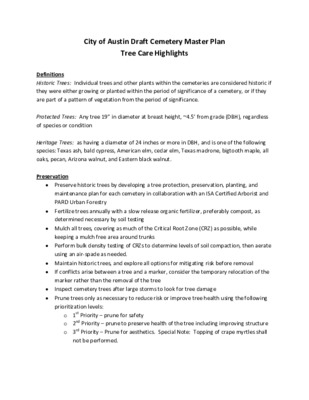Executive Liaison Report -- Draft Cemetery Master Plan Tree Care Highlights — original pdf
Backup

City of Austin Draft Cemetery Master Plan Tree Care Highlights Definitions Historic Trees: Individual trees and other plants within the cemeteries are considered historic if they were either growing or planted within the period of significance of a cemetery, or if they are part of a pattern of vegetation from the period of significance. Protected Trees: Any tree 19” in diameter at breast height, ~4.5’ from grade (DBH), regardless of species or condition Heritage Trees: as having a diameter of 24 inches or more in DBH, and is one of the following species: Texas ash, bald cypress, American elm, cedar elm, Texas madrone, bigtooth maple, all oaks, pecan, Arizona walnut, and Eastern black walnut. Preservation • Preserve historic trees by developing a tree protection, preservation, planting, and maintenance plan for each cemetery in collaboration with an ISA Certified Arborist and PARD Urban Forestry • Fertilize trees annually with a slow release organic fertilizer, preferably compost, as determined necessary by soil testing • Mulch all trees, covering as much of the Critical Root Zone (CRZ) as possible, while keeping a mulch free area around trunks • Perform bulk density testing of CRZs to determine levels of soil compaction, then aerate using an air-spade as needed. • Maintain historic trees, and explore all options for mitigating risk before removal • If conflicts arise between a tree and a marker, consider the temporary relocation of the marker rather than the removal of the tree • Inspect cemetery trees after large storms to look for tree damage • Prune trees only as necessary to reduce risk or improve tree health using the following prioritization levels: o 1st Priority – prune for safety o 2nd Priority – prune to preserve health of the tree including improving structure o 3rd Priority – Prune for aesthetics. Special Note: Topping of crape myrtles shall not be performed. • Ensure that new construction, markers, and plantings, and regular grounds maintenance activities do not negatively impact root systems of existing trees. Post oaks are called out for extra protection. • Implement a cyclical tree inspection and maintenance program • Educate cemetery maintenance staff about the importance of trees and their care Removals • Tree removals will only be done for safety reasons when no other solutions are possible • Removing any tree 3”in DBH or greater, regardless of condition, will require approval from PARD Forestry • All removals will be documented in the tree inventory for replacement purposes • Historic trees will be replaced with the same species, when possible, and replanted as close to the original location as possible. • Replacement trees will be documented with GIS technology, and added to the tree inventory Planting • New trees will be planted in locations noted in the plans for individual cemeteries • Appropriate native or adapted species will be planted for the particular soil types of each cemetery • Prior to excavation, sites will be investigated for subsurface cultural resources • Alternative planting methods, such as the mounding technique, may be used to plant in areas where excavation may damage historic or cultural resources Tree Inventory • A complete inventory of all trees and stumps in the five cemeteries was completed as a separate part of the master plan process on recommendation from the PARD Urban Forestry Program. • Attributes recorded included: site type, utilities, species, DBH, multi stem, vigor, structure, observations on any other tree issues, further inspection, and tag number • Data gathered in this inventory will be used to identify historic trees to preserve, develop maintenance and planting plans, and identify vegetation patterns within individual cemeteries • Tree condition was recorded, and this information has already been used to develop a scope of work for tree maintenance. This work has already begun. • The tree inventory data will be updated to reflect changes